Tripura-based screenwriter Biplab Goswami firmly denied the plagiarism allegations leveled against him regarding his critically acclaimed film Laapataa Ladies. The controversy erupted after social media users began drawing striking similarities between Goswami’s film and a lesser-known French-Algerian short film titled Burqa City. These comparisons quickly gained traction online, prompting debates on originality, intellectual property, and cross-cultural storytelling.
Goswami addressed the issue head-on, stating that he created the story and characters of Laapataa Ladies independently, without any knowledge of Burqa City. He expressed dismay over the backlash and called the accusations baseless. “I respect creative work globally, but I have never seen or heard of Burqa City until the recent posts started surfacing. The plot and spirit of Laapataa Ladies come from Indian soil, from our lived experiences, not borrowed ones,” Goswami asserted.
The film Laapataa Ladies, which was recently released to wide acclaim, revolves around two women who get lost on their way to a new life after marriage and find empowerment in unexpected ways. Social media critics pointed out that Burqa City also follows the theme of mistaken identity, women’s struggle, and eventual empowerment within a conservative social setting. But Goswami maintained that the resemblance is purely coincidental and that thematic overlaps are natural in global cinema.
Filmmaker Kiran Rao, who directed Laapataa Ladies, also supported Goswami’s claim of originality. She praised his rooted storytelling and noted that Indian cinema often draws on shared cultural motifs. “We did our due diligence while developing the script. Biplab’s story had its foundation in the rural heartlands of India and was born out of his observations and research. Any resemblance to other works is coincidental, not intentional,” Rao said in a recent interview.
Legal experts have weighed in on the matter, clarifying that thematic similarities do not necessarily equate to copyright infringement. In India, copyright laws protect the expression of an idea, not the idea itself. Therefore, unless there is direct evidence of copying dialogues, character names, or exact plot points, proving plagiarism remains difficult.
Goswami pointed out that the characters in Laapataa Ladies reflect uniquely Indian dilemmas. From arranged marriages and railway station mix-ups to the societal expectations placed on young brides, he said the narrative draws heavily from real-world anecdotes. “I have spoken to countless women in villages across India. Their stories inspired me. I would never insult their experiences by copying someone else’s work,” he added.
The production team behind Burqa City has not made any formal claim against Goswami or the Laapataa Ladies team. As of now, there has been no legal notice or official complaint. However, the online debate has persisted, with film critics and viewers taking sides based on their interpretation of the plots.
In response to the ongoing discourse, Goswami has urged audiences to appreciate both films in their own context. “Every culture tells stories about women’s identity, struggle, and transformation. These are universal issues. We must celebrate diversity in storytelling rather than pit artists against each other,” he said.
As the controversy unfolds, film festivals continue to showcase Laapataa Ladies internationally, with no disruptions to its screenings or reception. Audiences have largely responded positively to its blend of humor, social commentary, and emotional depth.
Goswami remains focused on his next project and has said that the current incident will not deter him from continuing to write bold, socially relevant stories. He expressed gratitude for the support he has received from the film fraternity and viewers who believe in his creative integrity.
With no legal challenge filed and public interest high, Laapataa Ladies may find itself remembered not only for its compelling storytelling but also for sparking a larger conversation about originality, inspiration, and artistic expression in a globally connected world.




